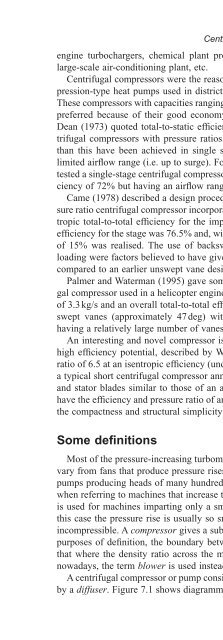Fluid Mechanics and Thermodynamics of Turbomachinery, 5e
Fluid Mechanics and Thermodynamics of Turbomachinery, 5e
Fluid Mechanics and Thermodynamics of Turbomachinery, 5e
Create successful ePaper yourself
Turn your PDF publications into a flip-book with our unique Google optimized e-Paper software.
engine turbochargers, chemical plant processes, factory workshop air supplies <strong>and</strong><br />
large-scale air-conditioning plant, etc.<br />
Centrifugal compressors were the reasoned choice for refrigerating plants <strong>and</strong> compression-type<br />
heat pumps used in district heating schemes described by Hess (1985).<br />
These compressors with capacities ranging from below 1MW up to nearly 30MW were<br />
preferred because <strong>of</strong> their good economy, low maintenance <strong>and</strong> absolute reliability.<br />
Dean (1973) quoted total-to-static efficiencies <strong>of</strong> 80–84% for small single-stage centrifugal<br />
compressors with pressure ratios <strong>of</strong> between 4 <strong>and</strong> 6. Higher pressure ratios<br />
than this have been achieved in single stages, but at reduced efficiency <strong>and</strong> a very<br />
limited airflow range (i.e. up to surge). For instance, Schorr et al. (1971) designed <strong>and</strong><br />
tested a single-stage centrifugal compressor which gave a pressure ratio <strong>of</strong> 10 at an efficiency<br />
<strong>of</strong> 72% but having an airflow range <strong>of</strong> only 10% at design speed.<br />
Came (1978) described a design procedure <strong>and</strong> the subsequent testing <strong>of</strong> a 6.5 pressure<br />
ratio centrifugal compressor incorporating 30deg backswept vanes, giving an isentropic<br />
total-to-total efficiency for the impeller <strong>of</strong> over 85%. The overall total-to-total<br />
efficiency for the stage was 76.5% <strong>and</strong>, with a stage pressure ratio <strong>of</strong> 6.8 a surge margin<br />
<strong>of</strong> 15% was realised. The use <strong>of</strong> backswept vanes <strong>and</strong> the avoidance <strong>of</strong> high vane<br />
loading were factors believed to have given a significant improvement in performance<br />
compared to an earlier unswept vane design.<br />
Palmer <strong>and</strong> Waterman (1995) gave some details <strong>of</strong> an advanced two-stage centrifugal<br />
compressor used in a helicopter engine with a pressure ratio <strong>of</strong> 14, a mass flow rate<br />
<strong>of</strong> 3.3kg/s <strong>and</strong> an overall total-to-total efficiency <strong>of</strong> 80%. Both stages employed backswept<br />
vanes (approximately 47deg) with a low aerodynamic loading achieved by<br />
having a relatively large number <strong>of</strong> vanes (19 full vanes <strong>and</strong> 19 splitter vanes).<br />
An interesting <strong>and</strong> novel compressor is the “axi-fuge”, a mixed flow design with a<br />
high efficiency potential, described by Wiggins (1986) <strong>and</strong> giving on test a pressure<br />
ratio <strong>of</strong> 6.5 at an isentropic efficiency (undefined) <strong>of</strong> 84%. Essentially, the machine has<br />
a typical short centrifugal compressor annulus but actually contains six stages <strong>of</strong> rotor<br />
<strong>and</strong> stator blades similar to those <strong>of</strong> an axial compressor. The axi-fuge is claimed to<br />
have the efficiency <strong>and</strong> pressure ratio <strong>of</strong> an axial compressor <strong>of</strong> many stages but retains<br />
the compactness <strong>and</strong> structural simplicity <strong>of</strong> a centrifugal compressor.<br />
Some definitions<br />
Centrifugal Pumps, Fans <strong>and</strong> Compressors 209<br />
Most <strong>of</strong> the pressure-increasing turbomachines in use are <strong>of</strong> the radial-flow type <strong>and</strong><br />
vary from fans that produce pressure rises equivalent to a few millimetres <strong>of</strong> water to<br />
pumps producing heads <strong>of</strong> many hundreds <strong>of</strong> metres <strong>of</strong> water. The term pump is used<br />
when referring to machines that increase the pressure <strong>of</strong> a flowing liquid. The term fan<br />
is used for machines imparting only a small increase in pressure to a flowing gas. In<br />
this case the pressure rise is usually so small that the gas can be considered as being<br />
incompressible. A compressor gives a substantial rise in pressure to a flowing gas. For<br />
purposes <strong>of</strong> definition, the boundary between fans <strong>and</strong> compressors is <strong>of</strong>ten taken as<br />
that where the density ratio across the machine is 1.05. Sometimes, but more rarely<br />
nowadays, the term blower is used instead <strong>of</strong> fan.<br />
A centrifugal compressor or pump consists essentially <strong>of</strong> a rotating impeller followed<br />
by a diffuser. Figure 7.1 shows diagrammatically the various elements <strong>of</strong> a centrifugal

















